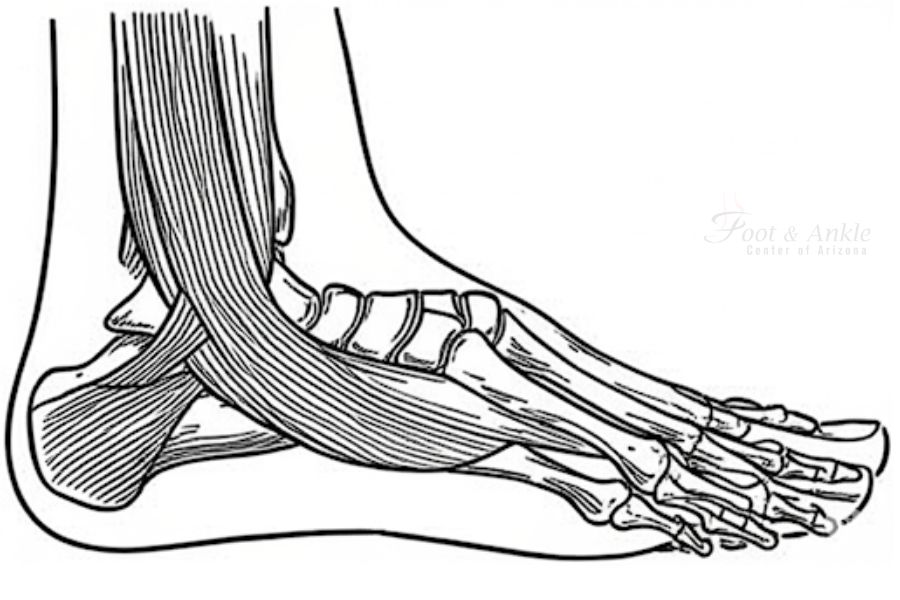The accessory navicular, also known as so navicular or so tibiae extremum. Is an additional bone or cartilaginous piece situated on the inner side of the foot, just above the arch. It becomes integrated with the posterior tibial tendon, which attaches in this region and can lead to the development of Accessory Navicular Syndrome.
An accessory navicular is congenital, meaning it is present from birth. It is not a part of the normal bone structure and is not present in most individuals.
What Is Accessory Navicular Syndrome?
While many individuals with an accessory navicular may be unaware of its presence. Some may develop a painful condition known as Accessory Navicular Syndrome when the bone and/or posterior tibial tendon become irritated. This irritation can result from various factors, including:
- Injuries, like a sprained foot or ankle.
- Chronic irritation from footwear that rubs against the extra bone.
- Excessive activity or overuse.
Many people with Accessory Navicular Syndrome also have flat feet. Which increases strain on the posterior tibial tendon and can lead to inflammation or irritation of the accessory navicular.
Signs & Symptoms of Accessory Navicular Syndrome
The symptoms of Accessory Navicular Syndrome often first appear during adolescence. A time when bones are maturing and cartilage is converting into bone. However, symptoms can also manifest in adulthood. Common signs and symptoms include:
- A visible bony prominence on the midfoot (inner side, just above the arch).
- Redness and swelling of the bony prominence.
- Vague pain or throbbing in the midfoot and arch, typically occurring during or after physical activity.
Diagnosis of Accessory Navicular Syndrome
To diagnose Accessory Navicular Syndrome, a foot and ankle surgeon will inquire about symptoms and conduct a thorough examination of the foot, checking for skin irritation or swelling. The doctor may apply pressure to the bony prominence to assess discomfort. Additionally, foot structure, muscle strength, joint motion, and gait may be evaluated. X-rays are typically ordered to confirm the diagnosis, and in cases of persistent pain or inflammation, advanced imaging like MRI may be used for further evaluation.
Nonsurgical Treatment Approaches
Nonsurgical treatment aims to alleviate the symptoms of Accessory Navicular Syndrome and may include:
- Immobilization: Placing the foot in a cast or removable walking boot allows the affected area to rest, reducing inflammation.
- Ice: Applying a bag of ice covered with a thin towel can help reduce swelling (avoid direct skin contact with ice).
- Medications: Nonsteroidal anti-inflammatory drugs (NSAIDs) like ibuprofen may be prescribed. In some instances, oral or injected steroid medications may be used. In combination with immobilization to reduce pain and inflammation.
- Physical Therapy: Exercises and treatments can strengthen muscles and reduce inflammation, potentially preventing symptom recurrence.
- Orthotic Devices: Custom orthotic devices fitted into shoes provide arch support and may help prevent future symptoms.
Even after successful treatment, symptoms of Accessory Navicular Syndrome may reappear. In which case nonsurgical approaches are typically repeated.
When Is Surgery Needed?
If nonsurgical treatment fails to relieve the symptoms of Accessory Navicular Syndrome, surgery may be considered. Surgical options may involve removing the accessory bone, reshaping the area, and repairing the posterior tibial tendon to enhance its function. It’s important to note that. The extra bone is not essential for normal foot function.
Why Choose a Foot and Ankle Surgeon?
Foot and ankle surgeons are the foremost experts in foot and ankle care today. As doctors of podiatric medicine, they possess specialized knowledge and training specific to the foot and ankle. Foot and ankle surgeons are board-certified surgical specialists in the field and are uniquely qualified to perform a wide range of surgeries, including those indicated for Accessory Navicular Syndrome, along with providing comprehensive care for all foot and ankle conditions across all age groups.




